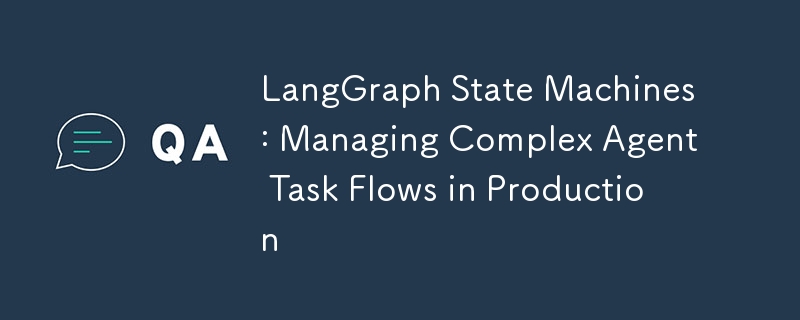Home >Backend Development >Python Tutorial >LangGraph State Machines: Managing Complex Agent Task Flows in Production
LangGraph State Machines: Managing Complex Agent Task Flows in Production
- Barbara StreisandOriginal
- 2024-11-24 03:37:091086browse

What is LangGraph?
LangGraph is a workflow orchestration framework designed specifically for LLM applications. Its core principles are:
- Breaking complex tasks into states and transitions
- Managing state transition logic
- Handling various exceptions during task execution
Think of shopping: Browse → Add to Cart → Checkout → Payment. LangGraph helps us manage such workflows efficiently.
Core Concepts
1. States
States are like checkpoints in your task execution:
from typing import TypedDict, List
class ShoppingState(TypedDict):
# Current state
current_step: str
# Cart items
cart_items: List[str]
# Total amount
total_amount: float
# User input
user_input: str
class ShoppingGraph(StateGraph):
def __init__(self):
super().__init__()
# Define states
self.add_node("browse", self.browse_products)
self.add_node("add_to_cart", self.add_to_cart)
self.add_node("checkout", self.checkout)
self.add_node("payment", self.payment)
2. State Transitions
State transitions define the "roadmap" of your task flow:
class ShoppingController:
def define_transitions(self):
# Add transition rules
self.graph.add_edge("browse", "add_to_cart")
self.graph.add_edge("add_to_cart", "browse")
self.graph.add_edge("add_to_cart", "checkout")
self.graph.add_edge("checkout", "payment")
def should_move_to_cart(self, state: ShoppingState) -> bool:
"""Determine if we should transition to cart state"""
return "add to cart" in state["user_input"].lower()
3. State Persistence
To ensure system reliability, we need to persist state information:
class StateManager:
def __init__(self):
self.redis_client = redis.Redis()
def save_state(self, session_id: str, state: dict):
"""Save state to Redis"""
self.redis_client.set(
f"shopping_state:{session_id}",
json.dumps(state),
ex=3600 # 1 hour expiration
)
def load_state(self, session_id: str) -> dict:
"""Load state from Redis"""
state_data = self.redis_client.get(f"shopping_state:{session_id}")
return json.loads(state_data) if state_data else None
4. Error Recovery Mechanism
Any step can fail, and we need to handle these situations gracefully:
class ErrorHandler:
def __init__(self):
self.max_retries = 3
async def with_retry(self, func, state: dict):
"""Function execution with retry mechanism"""
retries = 0
while retries < self.max_retries:
try:
return await func(state)
except Exception as e:
retries += 1
if retries == self.max_retries:
return self.handle_final_error(e, state)
await self.handle_retry(e, state, retries)
def handle_final_error(self, error, state: dict):
"""Handle final error"""
# Save error state
state["error"] = str(error)
# Rollback to last stable state
return self.rollback_to_last_stable_state(state)
Real-World Example: Intelligent Customer Service System
Let's look at a practical example - an intelligent customer service system:
from langgraph.graph import StateGraph, State
class CustomerServiceState(TypedDict):
conversation_history: List[str]
current_intent: str
user_info: dict
resolved: bool
class CustomerServiceGraph(StateGraph):
def __init__(self):
super().__init__()
# Initialize states
self.add_node("greeting", self.greet_customer)
self.add_node("understand_intent", self.analyze_intent)
self.add_node("handle_query", self.process_query)
self.add_node("confirm_resolution", self.check_resolution)
async def greet_customer(self, state: State):
"""Greet customer"""
response = await self.llm.generate(
prompt=f"""
Conversation history: {state['conversation_history']}
Task: Generate appropriate greeting
Requirements:
1. Maintain professional friendliness
2. Acknowledge returning customers
3. Ask how to help
"""
)
state['conversation_history'].append(f"Assistant: {response}")
return state
async def analyze_intent(self, state: State):
"""Understand user intent"""
response = await self.llm.generate(
prompt=f"""
Conversation history: {state['conversation_history']}
Task: Analyze user intent
Output format:
{{
"intent": "refund/inquiry/complaint/other",
"confidence": 0.95,
"details": "specific description"
}}
"""
)
state['current_intent'] = json.loads(response)
return state
Usage
# Initialize system
graph = CustomerServiceGraph()
state_manager = StateManager()
error_handler = ErrorHandler()
async def handle_customer_query(user_id: str, message: str):
# Load or create state
state = state_manager.load_state(user_id) or {
"conversation_history": [],
"current_intent": None,
"user_info": {},
"resolved": False
}
# Add user message
state["conversation_history"].append(f"User: {message}")
# Execute state machine flow
try:
result = await graph.run(state)
# Save state
state_manager.save_state(user_id, result)
return result["conversation_history"][-1]
except Exception as e:
return await error_handler.with_retry(
graph.run,
state
)
Best Practices
-
State Design Principles
- Keep states simple and clear
- Store only necessary information
- Consider serialization requirements
-
Transition Logic Optimization
- Use conditional transitions
- Avoid infinite loops
- Set maximum step limits
-
Error Handling Strategy
- Implement graceful degradation
- Log detailed information
- Provide rollback mechanisms
-
Performance Optimization
- Use asynchronous operations
- Implement state caching
- Control state size
Common Pitfalls and Solutions
-
State Explosion
- Problem: Too many states making maintenance difficult
- Solution: Merge similar states, use state combinations instead of creating new ones
-
Deadlock Situations
- Problem: Circular state transitions causing tasks to hang
- Solution: Add timeout mechanisms and forced exit conditions
-
State Consistency
- Problem: Inconsistent states in distributed environments
- Solution: Use distributed locks and transaction mechanisms
Summary
LangGraph state machines provide a powerful solution for managing complex AI Agent task flows:
- Clear task flow management
- Reliable state persistence
- Comprehensive error handling
- Flexible extensibility
The above is the detailed content of LangGraph State Machines: Managing Complex Agent Task Flows in Production. For more information, please follow other related articles on the PHP Chinese website!
Related articles
See more- How do I handle POST and GET variables in Python using different web frameworks?
- How to Manage Local and Production Settings in Django?
- How Can I Modify Output Formatting for Pandas Groupby Aggregation with Scientific Notation?
- How Can I Efficiently Iterate Through a Range of Dates in Python?
- It's so useful! Share these built-in Python modules!

